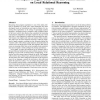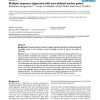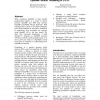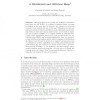2111 search results - page 283 / 423 » How to Program Pervasive Systems |
ICFP
2010
ACM
13 years 10 months ago
2010
ACM
Reasoning about program equivalence is one of the oldest problems in semantics. In recent years, useful techniques have been developed, based on bisimulations and logical relation...
ALMOB
2006
13 years 9 months ago
2006
Background: Automated software tools for multiple alignment often fail to produce biologically meaningful results. In such situations, expert knowledge can help to improve the qua...
MAM
2007
13 years 9 months ago
2007
This paper describes a new method of executing a software program on an FPGA for embedded systems. Rather than combine reconfigurable logic with a microprocessor core, this method...
CONCURRENCY
2000
13 years 9 months ago
2000
When comparing OpenMP to other parallel programming models, it is easier to choose between OpenMP and MPI than between OpenMP and POSIX Threads (Pthreads). With languages like C a...
ICALP
2009
Springer
14 years 10 months ago
2009
Springer
This paper shows how to build and maintain a distributed heap which we call SHELL. In contrast to standard heaps, our heap is oblivious in the sense that its structure only depends...




